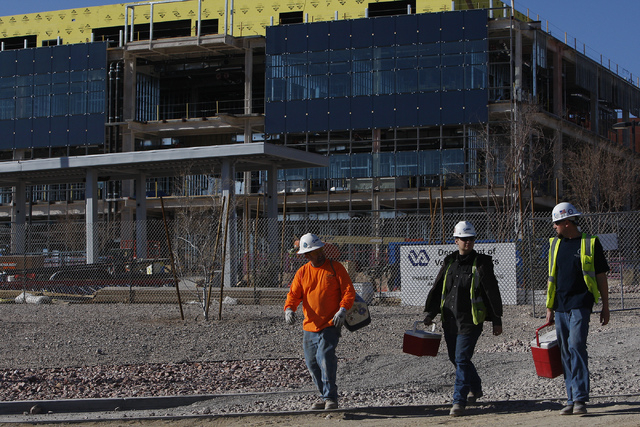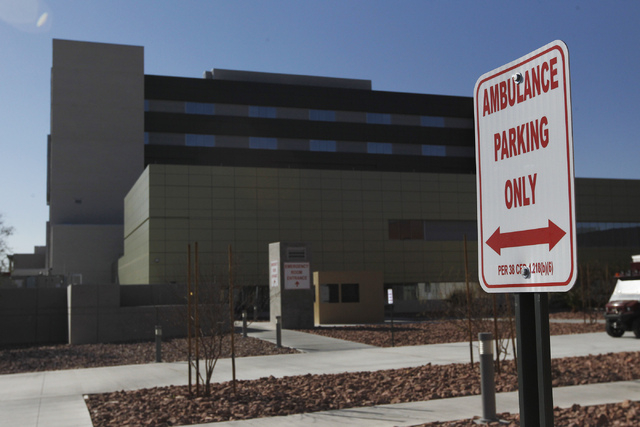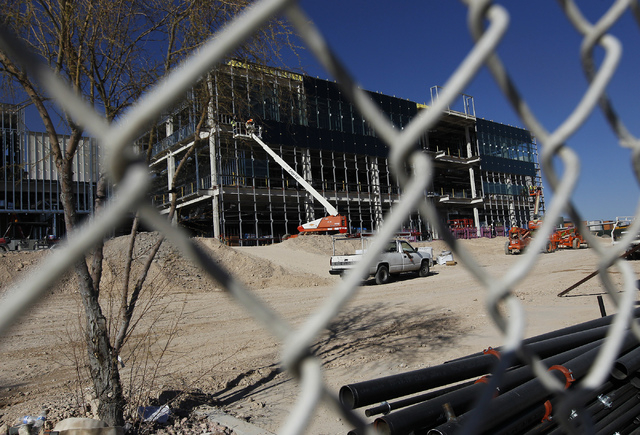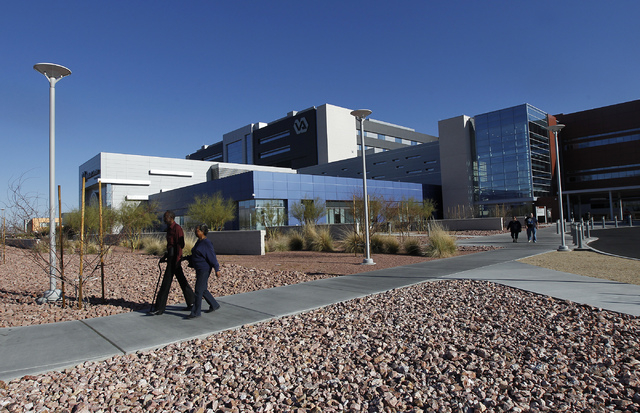New VA center’s emergency room already being expanded in North Las Vegas











Less than 1½ years after the Department of Veterans Affairs opened its $1 billion VA Medical Center in North Las Vegas, earthmovers have begun churning the site again, this time to expand the hospital’s emergency room because the existing one is inadequate.
Work has been underway for “a couple of weeks” on the new emergency room facility because the one that was built after a decade of planning and construction is too small for the caseload and lacks an ambulance drop-off ramp, local VA spokesman David Martinez said during a visit to the site Tuesday.
He said the new emergency room — a project costing more than $16 million — will add 14 beds to the 11 that are already part of the hospital, for a total of 25 emergency beds. The site is on a swath of public land on the Las Vegas Valley’s northern edge.
The expansion contract was awarded Sept. 30 to Halbert Construction. The company has a year to complete it from when the notice to proceed took effect on Jan. 17 — 17 months after the six-story, 1 million-square-foot medical center opened on Aug. 14, 2012.
Construction continues while workers near completion of the center’s administration building on an adjacent site at the 151-acre campus.
VA officials this week couldn’t explain why the ambulance parking area was designed to be roughly 50 yards from the emergency room’s south entrance, a distance that adds critical seconds to a lifesaving situation. Nor could they say who drew up the flawed design or who in the agency was responsible for checking the blueprints and allowed the design to proceed through construction.
As for the existing emergency room’s inadequate size, Isabel Duff, director of the Southern Nevada Healthcare System, which runs the North Las Vegas VA Medical Center, has acknowledged the ER facility lacks a convenient location for dropping off patients and has too few beds for the number of veterans who use it daily.
Duff discussed the emergency room situation in a December interview about the ordeal experienced by Navy veteran Sandi Niccum, a blind diabetic who waited six hours in pain on Oct. 22 in a near-empty waiting room for treatment of what doctors later determined was a ruptured abscessed colon.
Niccum, 78, died Nov. 15 at a local hospice. A VA inspector general’s team is investigating her emergency room ordeal.
Duff’s spokesman in Long Beach, Calif., Richard Beam, said after her Dec. 20 interview with the Las Vegas Review-Journal that the emergency room “was built based on the workload and the funding that was available at the time.”
But since the medical center’s inception, the number of potential veterans projected to use the center after it opened has remained constant at about 60,000 annually.
Eleven days before the medical center opened in 2012, then-Director John Bright said the $1 billion complex — which includes $600 million for medical center construction and $400 million for equipment, staffing and satellite clinics — serves about 46,000 veterans. Bright had sought more money for emergency room beds, but Congress didn’t approve his request.
He said that when the 90-in-patient-bed hospital and 120-bed nursing home care facility is fully operational, it would serve about 60,000 veterans. That was based on the 2010 census when the VA set Nevada’s veterans population at more than 234,000 with most — 164,225 — living in the Southern Nevada service area, including Nye and Lincoln counties.
That was consistent in 2004 when 41,000 veterans were enrolled for health care in the Las Vegas area and a VA study projected at least 63,000 would seek medical care by 2012.
The Government Accountability Office noted in a report last year that the design of the medical center has been a moving target over the years with the Mike O’Callaghan Federal Hospital at Nellis Air Force Base, which also serves veterans.
“VA officials told us that the Las Vegas Medical Center was initially planned to be an expanded clinic (collocated) with Nellis Air Force Base. However, VA later determined that a much larger medical center was needed in Las Vegas after it became clear that an inpatient medical center that VA shared with the Air Force would not be adequate to serve the medical needs of local veterans,” wrote Lorelei St. James, GAO’s director of physical and infrastructure issues.
“As a result, the cost of the project increased from an initial estimate of $325 million to a final estimate of $585 million — an increase of 80 percent.”
In 2007, VA officials attributed increased costs to escalating oil and gasoline prices and a significant demand for contractors, labor and building materials, including higher costs for steel driven by the lingering impact of Hurricane Katrina in New Orleans, where steel is produced.
From the time construction workers attached some of the first steel beams for the main medical center building in August 2008 to its dedication ceremony four years later, both then-VA Secretary James Peake and his successor, Secretary Eric Shinseki, have hailed the North Las Vegas VA Medical Center as the “crown jewel” of VA facilities. It was one of the first major medical facilities the VA had built in 17 years.
The effort to build a new VA medical center was launched in 2003 after its predecessor, the Guy Ambulatory Care Center on Martin Luther King Boulevard, with its walls crumbling and the odor of fecal matter circulating its hallways, was shut down for construction defects.
Meanwhile, the private Spring Valley Hospital took 18 months from start to finish to build on South Rainbow Boulevard. It opened in October 2003 with 210 beds at a $70 million cost.
Bradley Smith, a Navy veteran and former VA employee who worked on the North Las Vegas VA Medical Center’s Interior Design Department staff, said the emergency room could have been designed better and built cheaper.
“The emergency room is being rebuilt and relocated not really because it is too small but because it was built in a fundamentally dangerous location, way in the back of the parking lot beyond a maze of roads and parking areas,” Smith said.
“Patients and ambulances complained they couldn’t find it in an emergency situation. This is costing extra beyond the billion already spent.”
In its report in April, the GAO team concluded that “weaknesses in VA’s construction management” contributed to cost increases and delays.
To address the “lack of guidance and procedures,” a review council suggested having medical equipment planners on site with VA officials “clearly communicating the roles and responsibilities of VA construction staff to stakeholders, and streamlining” the process for making changes to the facility’s design.
Contact reporter Keith Rogers at krogers@reviewjournal.com or 702-383-0308. Follow him on Twitter @KeithRogers2.
Related story
PTSD victim’s wife recalls bad experience with new VA Medical Center












